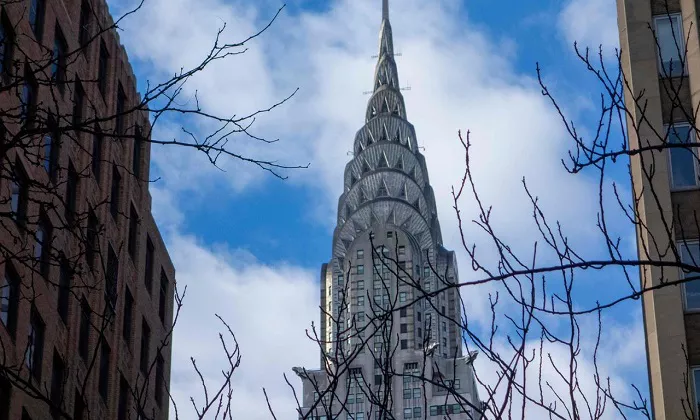New York (CNN) — Though it reigned as the world’s tallest building for less than a year, the Chrysler Building in Midtown Manhattan remains one of the most iconic skyscrapers ever built — a gleaming monument to Art Deco, the architectural movement celebrating its centennial on April 28.
Emerging in the 1920s and 1930s, Art Deco architecture revolutionized American skylines with a modern aesthetic that favored verticality, geometric motifs, bold ornamentation, and an innovative mix of materials. Buildings such as the Tribune Tower in Chicago and New York’s Waldorf Astoria exemplified the movement’s preference for originality over historical revival styles.
“Until the 1920s, American architecture largely looked back to Europe,” said Anthony W. Robins, architectural historian and founding member of the Art Deco Society of New York. “Art Deco marked a clear turn toward the future.”
Although the movement wasn’t formally named until 1966 — decades after its prime — its roots trace back to the 1925 “Exposition Internationale des Arts Décoratifs et Industriels Modernes” in Paris, a landmark event that attracted over 16 million visitors and influenced design worldwide.
At the heart of New York’s Art Deco boom stood the Chrysler Building. Completed in May 1930, the 1,046-foot tower briefly held the title of world’s tallest building, surpassing the Eiffel Tower before being overtaken by the Empire State Building just a year later. It was the pinnacle of a race to dominate the city’s skyline — a race that ended as the Great Depression stalled further supertall construction.
“The Chrysler and Empire State Buildings were the climax of the skyscraper boom,” Robins said. “They were symbolic of an era chasing height and grandeur.”
Designed by architect William Van Alen for automotive magnate Walter P. Chrysler, the building featured a steel frame, white and gray brick facade, and a soaring spire — which was secretly assembled inside the structure and raised in just 90 minutes to outmaneuver a rival skyscraper at 40 Wall Street.
Its design, culminating in a crown of radiating sunbursts and stainless steel spire, captured the spirit of innovation. The building’s use of Nirosta steel, a corrosion-resistant alloy from Germany, added a dazzling, silvery luster that continues to mesmerize.
“The way the light hits that metal — it knocks your socks off,” Robins remarked.
The Chrysler Building’s layered setbacks and ornamentation were also shaped by New York City’s 1916 Zoning Resolution, which mandated architectural recesses to prevent buildings from overwhelming streets with shadows. Van Alen transformed this constraint into a defining feature, adding sculptural pineapples, eagle gargoyles, and even Chrysler car hubcaps as decorative flourishes that hinted at the building’s purpose and patron.
Inside, the lobby showcases Moroccan red marble, yellow travertine floors, and Edward Trumbull’s monumental ceiling mural “Transport and Human Endeavor,” a tribute to human progress and the very building it adorns.
Despite its now-legendary status, early reception was mixed. Critics lambasted the surprise spire as a gimmick, and in 1931, critic Lewis Mumford described the facade’s decoration as “a series of restless mistakes.” Taste in architecture was also shifting. The functionalist International Style, with its emphasis on unadorned concrete forms, soon eclipsed the ornamental Art Deco.
Yet, public appreciation of Art Deco surged in the 1960s, alongside formal recognition of the style and landmark protection for many of its masterpieces. The Chrysler Building was designated a federal landmark in 1976 and a New York City landmark in 1978.
Van Alen, however, did not share in its enduring glory. His career faded after the project, entangled in a lawsuit with Chrysler over unpaid fees — which he eventually won. The building’s full realization didn’t occur until 1981, when lighting technicians finally illuminated its crown in accordance with his original vision.
“There’s no spire like it,” said Robins. “When you fly over Manhattan, that’s the one that catches your eye.”
Now a century after the birth of Art Deco, the Chrysler Building remains a beacon of ambition, beauty, and innovation — a timeless reminder of an era when architecture reached for the sky.

